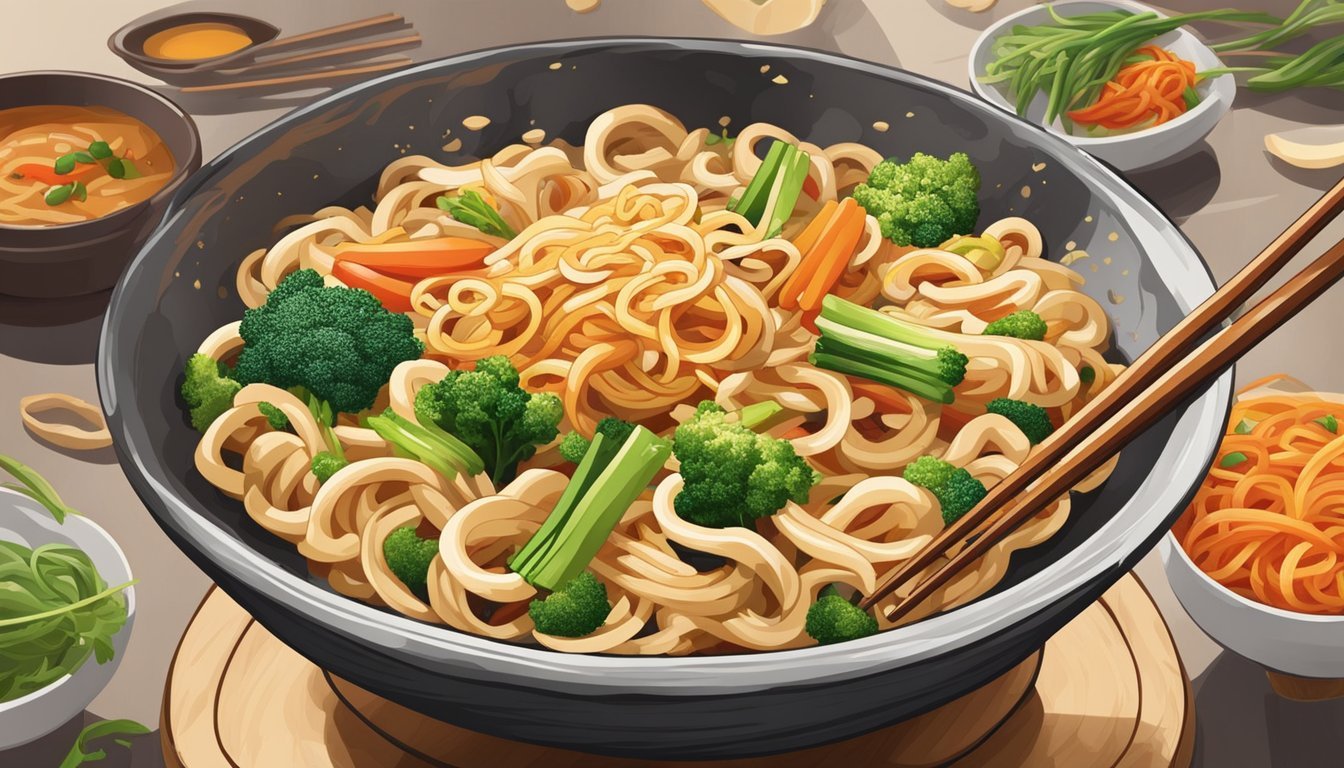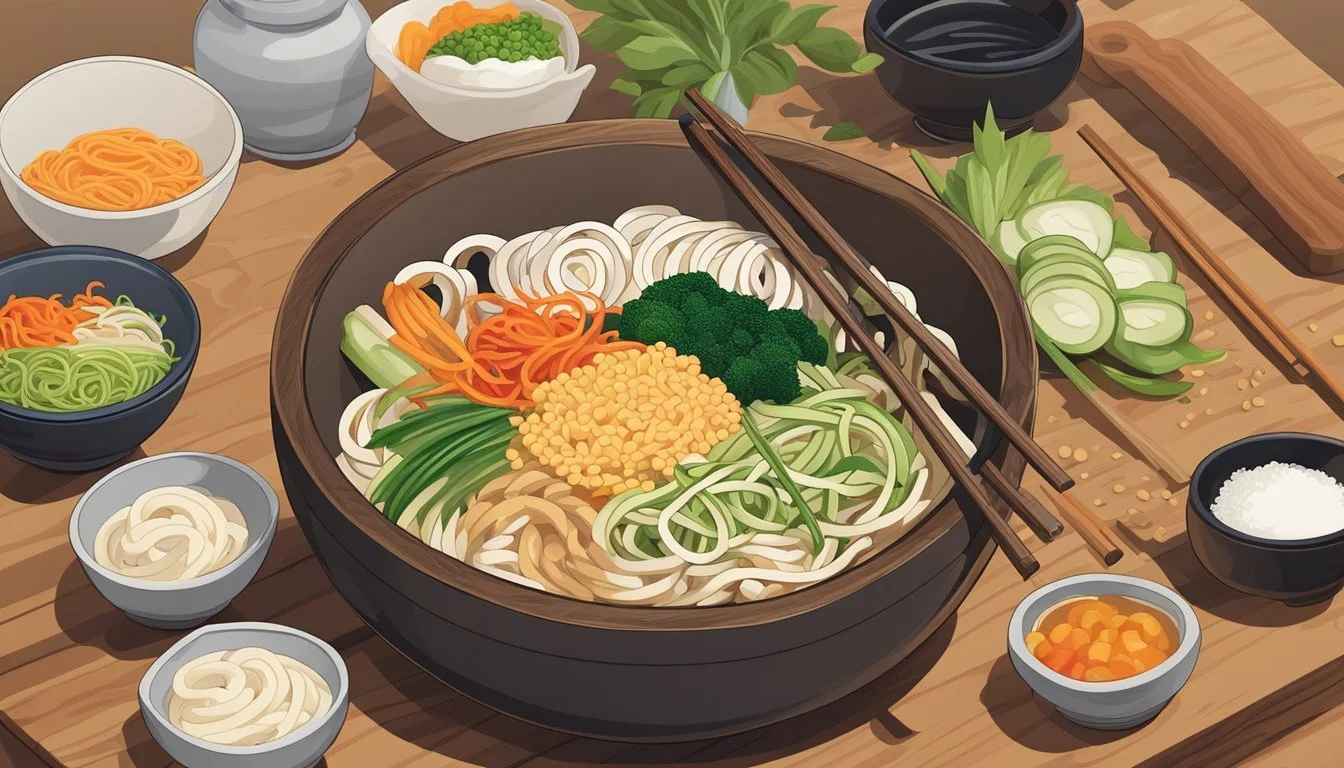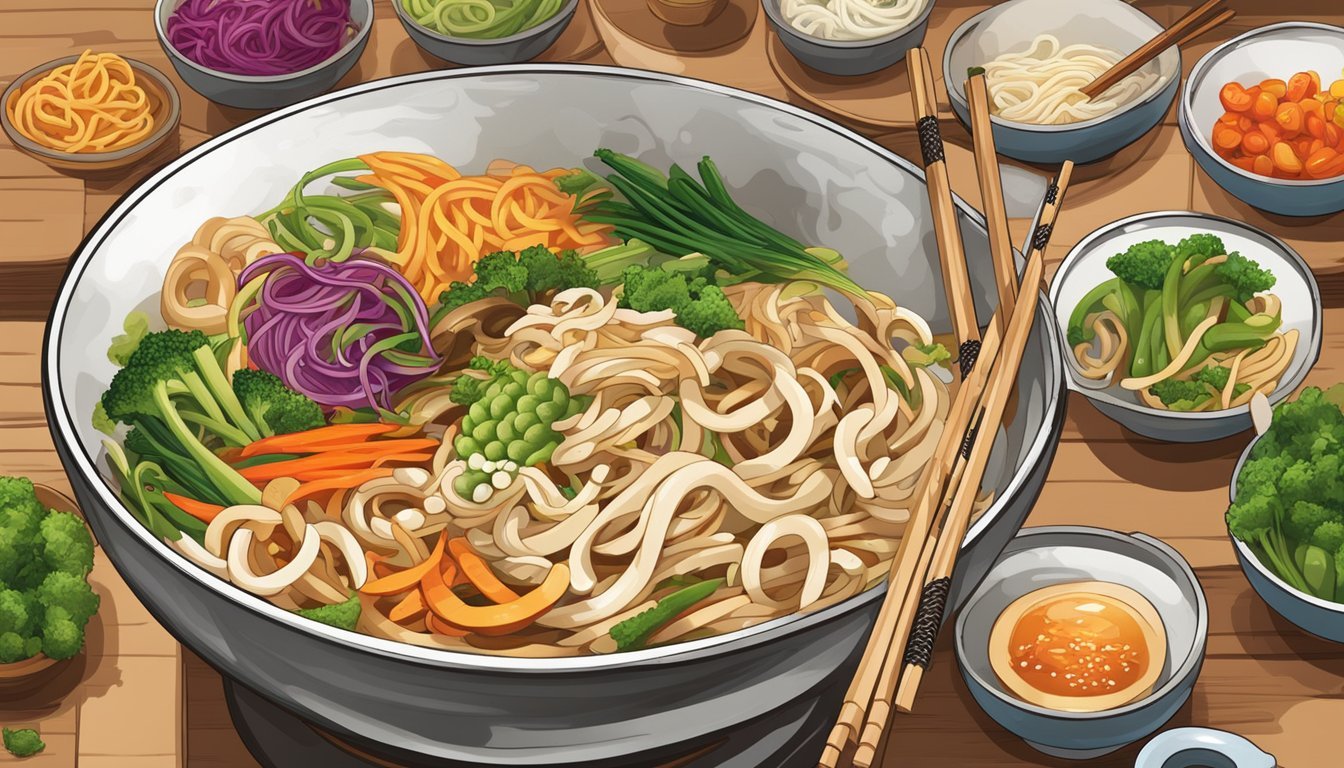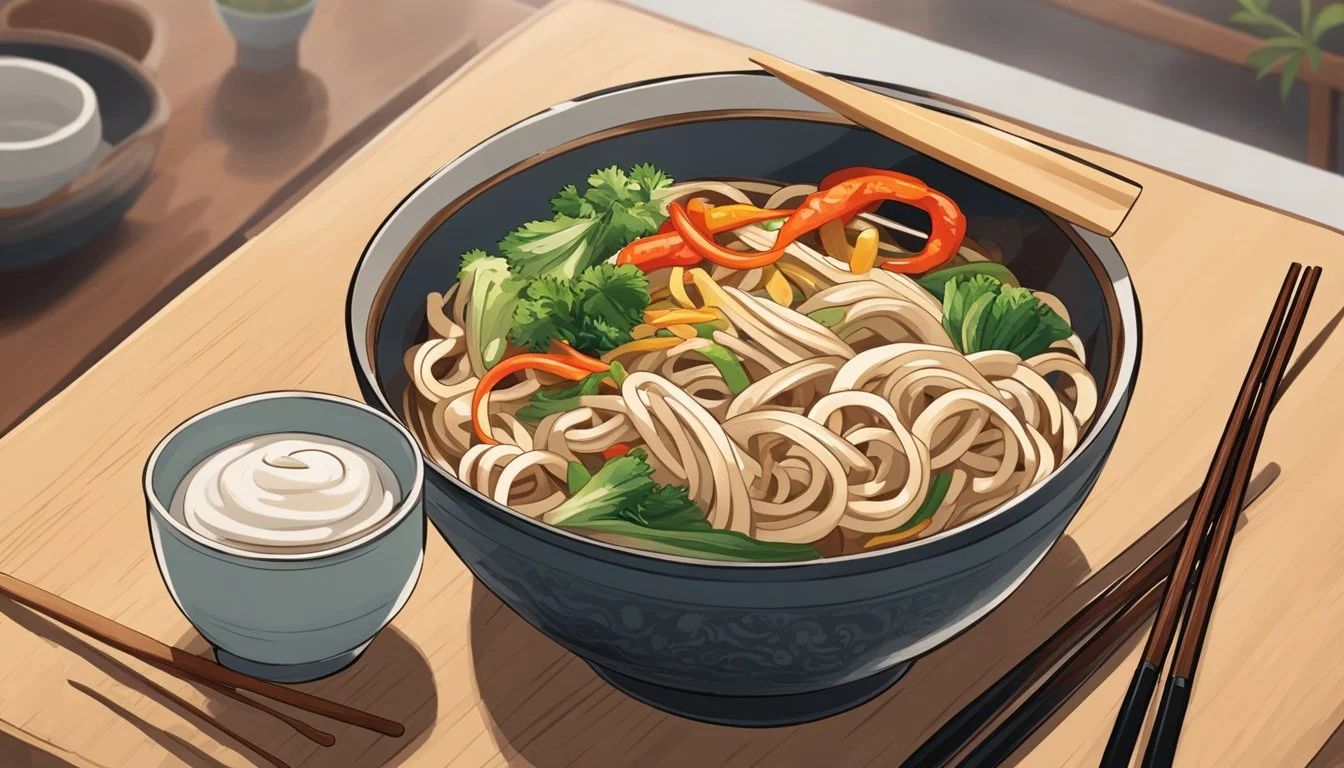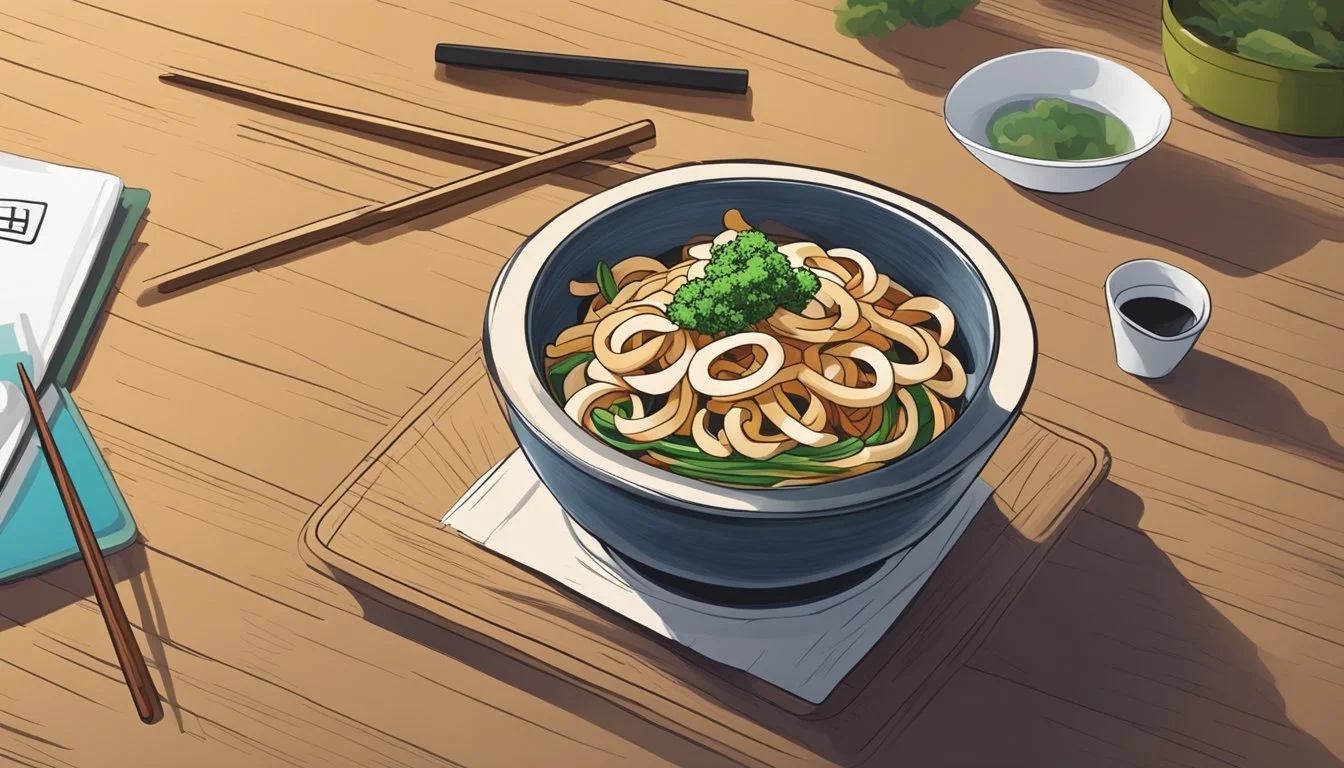How do you eat an udon stir fry?
Mastering the Perfect Technique
Eating udon stir fry is a delightful culinary experience that combines the chewy texture of udon noodles with a variety of flavors and ingredients. This dish is not only popular in Japanese cuisine but has also gained international acclaim for its versatility and satisfying nature. Udon stir fry is typically prepared by first stir frying meat or protein, then adding vegetables, and finally incorporating the udon noodles with a savory stir fry sauce. It's a one-pan meal that's quick to make and can be tailored to individual tastes, with options for different proteins like beef, chicken, or tofu, and a selection of vegetables like carrots, onions, and cabbage.
When enjoying udon stir fry, it is important to consider the balance of flavors and the cooking sequence of ingredients to maintain the ideal texture of the noodles. The udon should be soft yet retain a slight bounce, while the other components should be cooked to the right degree of tenderness or crispness. The sauce, often a mixture of soy sauce, sesame oil, and other seasonings, is the binding factor that unifies all the elements in the dish.
To eat udon stir fry, one usually uses chopsticks to pick up both the noodles and the toppings. It is appropriate to bring the bowl closer to the mouth when eating, to allow for a more graceful dining experience. The udon noodles may require some gentle slurping, which is acceptable in many Asian dining settings, and seen as a way to fully savor the dish's rich flavors. Udon stir fry offers a hearty, nutritious meal that reflects the simple yet purposeful approach to cooking found in many Asian cuisines.
Ingredients Overview
The components of a well-balanced udon stir fry encompass a variety of noodles, proteins, vegetables, and seasonings. Each category presents options allowing for a tailored dish that can suit any preference or dietary requirement.
Noodle Selection
Udon Noodles: Thick, chewy, and made from wheat flour, udon noodles are the centerpiece of the dish. They can be purchased as dried, refrigerated, or frozen. While fresh Japanese udon noodles offer a superior texture, frozen udon noodles are a convenient alternative that still maintains the traditional chewy consistency when prepared correctly.
Protein Choices
Protein: Options range from slices of pork, beef or chicken to seafood such as shrimp. For a meat-free alternative, tofu provides a substantial vegan or vegetarian protein. Ground meats like beef or pork can also be incorporated, ensuring that every forkful includes a savory bite.
Vegetable Assortment
Vegetables: A stir fry boasts a high fiber content thanks to its diverse range of veggies. Staples include onion, carrot, and cabbage, while mushrooms, broccoli, bell peppers (What wine goes well with bell peppers?), and snow peas add both color and crunch. For those who enjoy leafier textures, bok choy or spinach may be included, and minced garlic is a must for a fragrant touch.
Flavor Enhancers and Seasonings
Seasonings: The profound umami flavor in a udon stir fry comes from a blend of soy sauce, mirin, and oyster sauce, while sesame oil offers depth. Ginger and garlic are crucial for their aromatic qualities. Rice vinegar and a sprinkling of sesame seeds enhance the dish with acidity and texture respectively. Dark soy sauce can be employed for a richer color and flavor, and sriracha or other chili sauces introduce a spicy kick.
Additional Ingredients
Extras: Adding a splash of water can help to loosen the noodles and facilitate an even stir fry. Cooking oil is essential for sautéing the ingredients, with varieties like sesame or vegetable oil being popular choices. For those who like a touch of sweetness, a pinch of sugar can balance the flavors.
Essential Cooking Utensils
When preparing an udon stir fry, selecting the proper tools is just as crucial as the ingredients themselves. These utensils not only enhance the cooking process but also add to the authenticity and ease of dining.
Choosing the Right Wok or Pan
For an authentic udon stir fry, the chef needs a wok. This traditional Asian cooking vessel distributes heat evenly and has high, sloping sides perfect for stir-frying. Ideally, one should look for a wok with a sturdy handle and made of materials like carbon steel, which can withstand high temperatures without warping. A wok's design allows for quick cooking at high temperatures, ensuring vegetables stay crisp and noodles get a nice sear. If a wok is not available, a large, deep skillet can be a suitable alternative.
Recommended Wok Features:
Material: Carbon steel or cast iron
Size: 12 to 14 inches in diameter
Features: Flat bottom, long handle for tossing
Skillet Alternative:
Size: At least 12 inches
Depth: Sufficient for stirring and tossing ingredients
One can often find high-quality woks at an Asian grocery store, where staff can also provide advice on maintenance and care.
Serving and Eating Utensils
To serve and eat udon stir fry, specific utensils complement the experience.
For Serving:
Chopsticks: Ideal for plating the noodles and vegetables, providing precision.
Ladle or Wok Spatula: These are perfect for stir-frying and serving, allowing the chef to scoop up the noodles and ingredients with ease.
For Eating:
Chopsticks: They are the traditional choice and enable one to enjoy the dish as it's commonly eaten in its country of origin.
Large Bowls: A bowl allows the diner to mix the stir fry, ensuring even coverage of sauce and ingredients.
Asian Soup Spoon: This can be used to enjoy the delicious sauce that accompanies the stir fry.
The serving style often remains casual, with the stir fry served in communal dishes or individual bowls, depending on preference. Each diner is given their set of chopsticks for a complete udon experience.
Preparation Techniques
In creating a delectable udon stir fry, precision with preparation methods ensures a harmonious flavor blend and an enjoyable eating experience. Proper treatment of noodles and precise ingredient prepping are the cornerstones of successful stir fry making.
Noodle Prep Step-by-Step
Udon noodles are the foundation of the dish and require careful attention. One begins by boiling water in a large pot until it reaches a rolling boil. They can either immerse fresh udon directly into this water or, if using dry udon, they should boil them for about 5 minutes until fully cooked. For frozen udon, it is common to blanch the noodles. After boiling, they should promptly drain the noodles to prevent overcooking. An alternative method includes heating a bowl of hot water in the microwave for about 2 minutes, then soaking the udon in the hot water for 1 minute to loosen them before draining.
Cutting and Chopping
Consistency is key in chopping ingredients for a stir fry. Chefs should aim for uniformly sized pieces to ensure even cooking. They can cut meat into thin slices and chop vegetables like onions, carrots, and bell peppers into bite-size strips or pieces. As stir frying is a high-heat, quick-cooking process, having all components chopped and ready to go (a technique known as mise en place) is crucial before beginning to cook.
Measuring and Mixing
Before heating the pan, a chef should mix the stir fry sauce in a small bowl. This typically involves measuring out precise quantities of oyster sauce, soy sauce, sesame oil, and rice vinegar, and often a pinch of black pepper or chili oil for heat. One can whisk these ingredients together until fully combined. The sauce's balance of flavors is essential, and adjusting it to taste before cooking can prevent the need to correct it while stir frying, saving valuable prep time and maintaining the flow of the cooking process.
Note: To ensure proper safety and quality, links to products and cooking ware should be checked for reliability and should not have affiliate links without proper disclosure.
Cooking Methodology
In preparing a delicious stir fry, precision in timing, sequence, and heat management plays pivotal roles to maintain the chewy texture of udon noodles without them turning mushy or overcooked.
Mastering the Stir Fry Technique
The stir fry method is essential to achieving the savory and diverse tastes characteristic of Japanese stir fried udon noodles. It requires high heat and quick movement. Begin by heating a wok or large frying pan and adding a suitable amount of oil to coat the bottom. The oil must be hot enough to sizzle upon contact with the ingredients yet should not be smoking excessively.
Sautéing the Components
Each component should be sautéed to perfection. Proteins such as thinly sliced meat or tofu are cooked until they reach the appropriate internal temperature, and then set aside. Vegetables are then added—commonly bell peppers, carrots, and onions—and sautéed until they're tender-crisp to preserve their natural textures.
Combining Ingredients Sequentially
Yaki udon recipes highlight the importance of adding ingredients in stages. Once the sautéed vegetables are cooked, the earlier cooked protein is reintroduced along with the cooked udon noodles. These ingredients are stirred together swiftly to integrate flavors and ensure that each noodle is coated with the sauce, avoiding any clumps that could lead to uneven cooking. This sequence helps to maintain a chewy texture in the noodles, prevents them from becoming overcooked, and contributes to a delightful stir-fried dish. The stir fry is typically fast, making it a convenient yet satisfying meal option.
Post-Cooking Tips
After enjoying a flavorful udon stir fry, one can further enhance the experience with proper storage and presentation techniques for any leftovers. These steps ensure the dish remains as enjoyable as the initial serving.
Optimizing for Leftovers
When storing leftovers, it's crucial to transfer the udon stir fry to an airtight container as soon as it cools down to room temperature. This preserves the freshness and prevents the noodles from becoming too soft or soggy. If the udon stir fry contains green onions, one might consider storing them separately to retain their crisp texture. For reheating, a quick stint in a skillet on medium-high heat revitalizes the flavors and restores the slight crispness to the noodles.
Garnishing and Presentation
Before serving the udon stir fry, whether freshly cooked or reheated, garnishes play a significant role in both taste and visual appeal. A sprinkle of sesame seeds can add a nutty flavor and a pleasing crunch. Finely chopped green onion not only introduces a fresh, sharp taste but also adds a vibrant color contrast to the dish. When plating, one should aim for a balance between aesthetics and practicality, ensuring that the garnish is evenly distributed to complement every bite.
Serving Suggestions
When serving udon stir fry, presentation and accompaniments can greatly enhance the dining experience. Choosing the right sides and drinks to complement the rich flavors and texture of the udon noodles is essential.
Accompaniments and Sides
Udon stir fry can stand as a hearty, flavorful main dish that pairs well with a variety of sides. To balance the meal:
Vegetable Tempura: A selection of battered and fried vegetables such as sweet potato and zucchini.
Miso Soup: A light and soothing soup that provides a contrast to the stir-fried udon.
Pickled Ginger: Offers a refreshing and palate-cleansing zing between bites.
For those preferring alternatives to udon, similar stir-fries can also be prepared with rice noodles for a smoother texture, or soba noodles which offer a nuttier flavor. Yakisoba, a similar dish using wheat-based noodles, also serves as a delightful side dish or an alternative main course.
Pairings with Drinks
The right beverage can accentuate the flavors of an udon stir fry:
Green Tea: A traditional choice that complements the rich taste of the stir fry without overpowering it.
Sake: A Japanese rice wine that comes in various styles and flavors, ideally served warm or at room temperature.
Beer: A crisp Japanese lager can cut through the dish's richness and refresh the palate.
By selecting thoughtful side dishes and drink pairings, one can create a balanced and authentic dining experience that highlights the udon stir fry at the center of the meal.
Time Management
Managing the time effectively can be the difference between a rushed, unsatisfactory meal and a delicious, stress-free dining experience. The overall goal is to produce a satisfying udon stir fry meal within 20 minutes, acknowledging that a person might only have a 15-minute window for actual cooking due to various constraints.
Quick and Efficient Approach
The secret to a quick and efficient udon stir fry lies in the preparation and cooking technique. The stir frying process itself is inherently fast – typically taking about 3 to 5 minutes to fry individual components and an additional 2 to 3 minutes to bring everything together when using already cooked, refrigerated noodles. Here are steps and estimated times for an effective stir-fry method:
Heat the pan/wok: approximately 1 minute.
Cook protein: (example: shrimp or beef) approximately 2-3 minutes.
Vegetable cooking: quick sautéing, taking about 2-3 minutes.
Combine and heat through: noodles with other ingredients for 3 minutes.
Planning Ahead
For those pushing against a 20-minute total time frame, planning ahead is crucial. Activities to be done before the actual cooking begins include:
Ingredient Prep: Cut vegetables and proteins into bite-sized pieces.
Sauce Mixture: Whisk ingredients for the stir fry sauce in advance.
Noodle Prep: If using dried noodles, pre-cook them or have fresh or pre-cooked noodles on hand.
By attending to these activities before the intended meal time, one can easily stay within the 15-minute active cooking time. This ensures a quick turnaround from kitchen to table, delivering a hot, flavorful udon stir fry promptly.
Alternative Dietary Options
Udon stir fry is a versatile dish that can be easily adapted to meet a variety of dietary requirements. Below are guidelines to modify this dish for gluten-free needs and to make vegan and vegetarian-friendly variants.
Adapting for Gluten-Free Needs
For individuals with gluten sensitivities or celiac disease, traditional udon noodles, which contain wheat flour, must be substituted. Rice noodles are an excellent alternative as they are inherently gluten-free and can complement the texture of the dish. One must ensure that all sauce ingredients, such as soy sauce, are replaced with gluten-free options to prevent any gluten exposure.
Making Vegan and Vegetarian Variants
Creating a vegan or vegetarian version of udon stir fry involves careful selection of protein sources and condiments. For a vegetarian option, eggs may be included. However, for a vegan variant, tofu is a preferred protein due to its versatility and ability to absorb the flavors of the sauce and vegetables. It’s essential to use vegan-friendly sauces and broths in the preparation. Vegan garnishes such as sliced green onions can enhance the dish's appearance and add an extra layer of flavor.
Health and Nutrition
Udon stir fry offers a versatile and balanced meal that can be tailored to meet dietary needs. It typically provides a good mix of macronutrients and can incorporate a variety of vegetables.
Caloric and Macronutrient Information
Udon noodles are primarily a source of carbohydrates, with each serving usually containing around 40 grams of carbs. The caloric content of udon stir fry can vary greatly depending on the ingredients used, but an average serving might contain approximately 250-300 calories. Protein content can be increased by adding lean meats or tofu, while using vegetable oil in moderation can help control fat intake.
Nutrient Amount per serving Calories 250-300 Carbs 40g Protein Varies Fat Varies
Balancing the Food Groups
A well-rounded udon stir fry should include:
Protein: Add chicken, beef, tofu, or shrimp to provide the body with essential amino acids.
Vegetables: Pack in snow peas, bell peppers, onions, and broccoli for a fiber boost and vital nutrients.
Carbs: Udon noodles are a chewy and satisfying base that imparts energy.
Incorporating a diverse range of vegetables not only enhances the dish’s nutritional profile but also adds color and texture.
Benefits of Cooking at Home
By preparing udon stir fry at home, one can control the quality of ingredients and the cooking methods used. Homemade versions often contain:
Less Sodium: Home cooks can choose low-sodium sauces and control the amount of salt added.
More Fiber: One can opt for whole-grain udon noodles and include a generous portion of vegetables.
No Added Sugars: Cooking at home means sauces can be made without the added sugars that are often found in store-bought versions.
This control results in a healthier, more nutritious dinner or lunch, perfect for weeknight meals.
Storage and Shelf Life
When it comes to udon stir fry, maintaining the freshness and texture of the dish is paramount for enjoyable consumption. Proper storage is key for preserving its quality and extending its shelf life.
Refrigerator and Freezer Guidelines
Udon stir fry can be kept in the refrigerator for up to 5 days when stored in an airtight container. For longer storage, it can be placed in the freezer where it will last for 1-2 months. One should note that cooked udon noodles have a slightly shorter fridge lifespan compared to their raw counterparts.
Fridge: Up to 5 days in an airtight container
Freezer: 1-2 months in a freezer-safe container
For frozen udon noodles not used in a stir fry, they can be stored in the freezer for approximately 3 months. Always ensure the packaging is intact to prevent freezer burn.
Reheating Best Practices
To reheat udon stir fry, using a microwave or stovetop is suggested to preserve the texture of the noodles. In the microwave, the dish should be covered and heated on high for about 2 minutes, stirring halfway through. On the stovetop, a non-stick pan is ideal for reheating. Cook over medium heat until heated through, which typically takes around 5 minutes.
Microwave: High for 2 minutes, covered, stirring halfway
Stovetop: Medium heat, non-stick pan, stir occasionally, about 5 minutes
For frozen udon noodles, it is recommended to thaw them in the refrigerator overnight before reheating or adding directly to the stir fry as per cooking instructions. This helps in retaining their desirable chewy texture.
Frequently Asked Questions
This section is designed to address some of the most common questions and issues that arise when preparing and enjoying udon stir fry.
Common Inquiries and Concerns
What is the base flavor of udon stir fry sauce?
The base flavor of the sauce used in udon stir fry typically includes soy sauce, which is an essential Asian condiment, often mingled with mirin (a sweetened rice wine) for a balance of savory and sweet tones.
Is udon stir fry authentically Japanese?
Yes, udon stir fry, also known as Yaki Udon, is a traditional Japanese dish that incorporates stir-fried noodles with various ingredients such as vegetables and meats in a savory sauce.
Troubleshooting Preparation and Cooking
How can one prevent udon noodles from getting mushy or overcooked?
The key to preventing noodles from becoming mushy is to cook them until just underdone prior to adding them to the stir fry, as they will continue to cook with the other ingredients.
What should I do if my stir fry is too salty?
If the stir fry is overly salty, one can try adding a squeeze of lime or lemon for acidity, or a bit more of the ingredients that are not seasoned, like vegetables or unsalted stock, to balance out the flavors.
Variations and Substitutions
Are there alternatives for mirin in udon stir fry?
For those who do not have mirin, one can use a combination of white wine vinegar or rice vinegar with a little sugar as a substitute.
Can udon stir fry accommodate dietary restrictions?
Udon stir fry is versatile and substitutions are easily made to accommodate dietary restrictions. For example, tamari can be used instead of soy sauce for gluten-free diets, and tofu can replace animal proteins for a vegetarian version.
Please note, while this article may recommend ingredients or products, no affiliate links or commission-based recommendations are involved.
Conclusion
Eating udon stir fry is a delightful experience when one has the right recipe and technique. The thick, chewy noodles blend harmoniously with a variety of flavors and ingredients, providing a meal that one can customize to their personal taste preferences. Anyone can prepare this dish with confidence, armed with a fundamental recipe and a bit of culinary creativity.
To ensure the best quality:
Choose the right oil: Select an oil with a high smoke point, like vegetable, canola, or sesame oil, for stir-frying the udon noodles effectively.
Prep time: Gather all ingredients before starting to cook, as the stir-fry process is quick.
Cooking process: Start by stir-frying the meat until it’s just shy of being fully cooked. Then add in the vegetables.
Sauce: Adjust the amount of sauce based on personal preference; add it to the noodles and continue stir-frying for a uniform flavor.
Final touches: Add in any desired garnishes, such as scallions, for an extra layer of taste and a visually appealing dish.
Presenting the stir-fried udon is just as important as the preparation. Serve it hot and promptly for optimal enjoyment. This Asian culinary staple is versatile and can be adapted to suit various dietary requirements and tastes. The methodical approach to cooking this noodle dish ensures a satisfying meal experience each time. It reflects a balance of knowledge, technique, and the ability to adapt the recipe to one’s own palate, solidifying udon stir fry as a staple for anyone looking to explore the richness of Asian cuisine.

